In 2005, we commemorate 50 years after the first heart surgery using cardiopulmonary bypass (CPB) in Brazil. The pioneer of CPB was Professor Hugo João Felipozzi who also constructed the first CPB apparatuses in Brazil. His vision, focusing all effort on the production of national CPB equipment, enabled an enormous expansion in this area and the development of the high quality that Brazilian Heart surgery knows today.
Few countries have the vigor that Brazilian heart surgery currently enjoys. Together with the quality of scientific production, another factor that strongly contributed to the great importance of Brazilian heart surgery worldwide was the focus given to the national production of equipment, making the specialty practically independent of imported products.
This strategy was only possible because of the course chosen by the pioneers of Brazilian heart surgery. Among these pioneers is the eminent Professor Hugo João Felipozzi who, with a combination of persistent and focused work and endeavored vision, led the research that culminated in the construction of the first artificial heart-lung machine made in Brazil and in the first open-heart surgeries.
On October 15, 1955, the first open heart surgery of the pulmonary valve was performed using cardiopulmonary bypass making a selective shunt from the right heart. In the following year, on November 12th, the first patient was operated on in whom the heart chambers were opened under total cardiopulmonary bypass [1,2].

Professor Hugo João Felipozzi

Cardiopulmonary bypass machine with roller pump and Kay-Cross-type disc oxygenator used in the first surgery with total cardiopulmonary bypass.
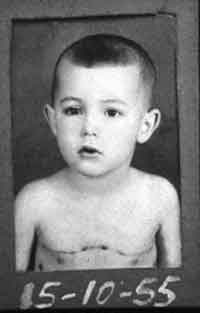
Picture of the first patient operated on for stenosis of pulmonary valve on October 15th, 1955.
Hugo João Felipozzi was born on September 6th 1923, in the town of Cajuru, interior of São Paulo state, son of Italian immigrants from the Piemonte region. During his childhood, for a short time, he returned with his parents to Italy (Val d'Aosta), where he attended primary school. He graduated in Medicine at the Paulista Medical School in 1947 when he specialized in general surgery.
In 1951 he headed to the United States to get more experience in thoracic surgery. At that time, soon after World War II, thoracic surgery was developing rapidly due to the return of surgeons who had acquired great experience in the treatment of patients with thoracic injuries. He trained with Willis J. Potts, who was one of the most experienced surgeons in the new area of surgically treated congenital heart diseases, in the Children's Memorial Hospital, in Chicago.
Back in Brazil, Felipozzi worked in Hospital São Paulo, as head of one of the three thoracic surgery teams. The other two teams were led by Dr. Ruy Margutti and Dr. Euryclides de Jesus Zerbini. Their combined experience of 208 cases of closed mitral comissurotomy, was reported in 1957 in the Brazilian Medical Association Journal (Revista da Associação Médica Brasileira) [3].
In 1953, Felipozzi together with Charles W. Lillehei stayed for a period in the University of Minnesota, which at that time was a great center developing bold techniques for the treatment of heart diseases; techniques such as crossed circulation and use of cardiopulmonary bypass with bubble oxygenators. He also spent some time at the Mayo Clinic, Baylor University and other centers.
His work in the development of cardiopulmonary bypass
Back in Brazil again, Felipozzi initiated studies on the construction of an artificial heart-lung machine, since the cost of imported machines was higher than most services could afford. He had brought several drawings and photographs of artificial heart-lung machines, as well as many materials and apparatuses which were almost impossible to obtain in Brazil at that time, including plastic tubes, silicon and resins.
However, it was only with the creation of the "Sabbado D'Angelo" Cardiology Institute in São Paulo, thanks to his sponsor Dr. Agostinho Janequine and to the Anita Pastore D'Angelo Foundation, that the infrastructure and resources necessary for the development of CPB were obtained.
This allowed research to be initiated with the collaboration of a valuable full-time and exclusive team. Some cardiologists should be cited: Prof. Adauto Barbosa Lima and Prof. Maria Vitória Martin, both of whom specialized in the service of Dra. Helen Taussing in John Hopkins Hospital and André H. J. Nicolai from the service of Professor Silvio Borges of Paulista Medical School. In the clinical laboratory, Professor Sergio Paladino, specialized in biochemistry in the Paulista Medical School, accompanied the experimental and clinical phases of CPB, offering support in the control of metabolic and acid/base, blood and pharmacological disorders. Hemodynamic studies were performed by Dr. Adauto Barbosa Lima and angiography and radiology by Dr. Hortêncio Medeiros Sobrinho.
The surgical assistants were Dr. Rubens de Guimarães Santos (today PhD of cardiovascular surgery of Medical Sciences School of Santa Casa de São Paulo) and Dr. Laio Gomes D'Oliveira. Dr. José dos Santos Perfeito was the perfusionist. Dr. Pedro Geretto, who later became head of the Anesthesia Department in the Paulista Medical School, was in charge of both clinical and experimental anesthesia.
Several trainee doctors, with full-time scholarships, provided by the Anita Pastore D'Angelo Foundation, came from other services in Brazil and other South American countries received clinical and surgical education in the institution.
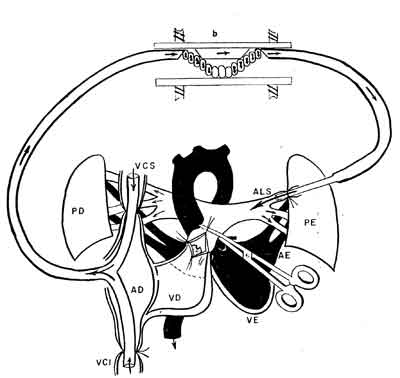
Diagram of the first surgery performed with a direct heart shunt. Venous blood was suctioned by a cannula placed in the vena cava using a Sigmamotor pump. This same pump impelled the blood that returned through a cannula placed in the superior left lobar artery. The pulmonary artery was distally clamped, opened, the pulmonary valve exposed and a commissurotomy performed
Initially a series of experiments on redirection of the circulation was performed in dogs using a Sigmamotor pump and a reduction in the flow according the "Azygos Factor" principle, established by Andreasen and Watson [4], using an autologous lung for oxygenation based on the work of Dodrill et al. With this method, Felipozzi and collaborators verified the possibility of intervening using open heart surgery for stenosis of the pulmonary valve and infundibular without septal disorders. The first patient of this group, a 3-year-old boy diagnosed as having pulmonary valve stenosis was operated on October 15 1955, with commissurotomy of pulmonary valve. This procedure was used successfully on six patients [5].
In November 1955, a one-year and three-month-old child with tetralogy of Fallot suffering from repetitive anoxia was operated on. The technique used was continuous perfusion with homologous arterialized blood [6]. The volume of arterialized blood was calculated to permit perfusion using a Sigmamotor pump calibrated for a flow rate three times greater than that of the azygos factor during one hour of surgery. The total intracardiac time for the correction of the interventricular communication and infundibular stenosis was 40 minutes. The surgery elapsed without complications, but on the 39th postoperative day the patient presented with pulmonary atelectasis and died of respiratory insufficiency.
Following this, a model of disc oxygenator was projected similar to the one of Craaford-Senning, which was built in the workshops of Anita Pastore D'Angelo Foundation. The Craaford-Sening-type oxygenator, when tested in experimental surgery, demonstrated a capacity of maintaining adequate tissue perfusion, normal values of acid/base balance, however, there were still high hemolytic levels with CPB of more than 30 minutes. This factor, as well as the great volume of blood needed as the perfusate, led to research for other models.
A new experimental series was performed with a DeWall-type bubble oxygenator and Sigmamotor pump [7]. Fifty dogs were operated on using this set of equipment; in 18 animals embolic events were observed probably due to the antifoam silicone (antifoam A) of the bubble removal chamber. Thus, it was decided to begin a new project constructing a rotating disc oxygenator similar to the Kay-Cross model and setting it up with roller-type pump [8]. In this model, the perfusate volume was reduced to 500 mL of heparinized blood that permitted adequate transference of oxygen per minute with a rotation of discs of around 90 rpm without causing turbulence in the blood. An adequate acid-base balance was maintained and the hemolysis rates remained at subclinical levels, in perfusion cycles of up to 2 hours. This model, which was tested over four months on 80 dogs and accompanied by a strict laboratorial control, was safe to use in the clinic.
On November 12, 1956, the first CPB was successfully performed using this equipment to correct an interatrial communication (IAC) of an 8-year-old child. By Christmas of that year, eight patients had already been operated on without complications, four of whom had suffered IAC-type ostium secundum, two partial anomalous draining of pulmonary veins associated to IACs and two had IAC-type ostium primum [9].
In 1957, already with CPB apparatuses under full development, heart surgeries were routine, including corrections of the tetralogy of Fallot utilizing an intracardiac access through the right atrium; partial corrections of atrioventricular canals, congenital aortic stenosis among other diseases [10, 11].
However, several factors at that time limited the number of surgeries using CPB to two or, at the maximum, three patients per week.
Blood collected in heparin on the day or at any rate on the day before the surgery was utilized and thus, a large number of donors was needed. The measurement of blood gases and electrolytes, both during surgery and in the immediate postoperative period, were still achieved by laborious and slow laboratorial methods. Hospitals did not have intensive care units so some rooms were transformed into recovery rooms for heart surgery patients with limited equipment and the staff worked hard on duty in the postoperative period.
Limitations in the acquisition of materials to manufacture CPB machines were still considerable. Polyvinyl plastics (Tygon), used in the fabrication of tubes for the extracorporeal circuit, had to be imported since the national ones were contaminated, with elements including lead. These and other problems needed to be solved before expanding the surgical program. Thus, with the clinical experience of the first two years of CPB and the better control of the biochemical extracorporeal circulation, blood collected in an ACDP solution and partially diluted with plasma and serum began to be used [12]. With his usual determination, Felipozzi succeeded in motivating the Brazilian plastic tubes industry of Romil in Campinas, São Paulo and to fabricate them with specifications identical to the Tygon tubes.
In this phase, the artificial heart-lung machine was substituted by a new model, which was created with a significant collaboration of Dr. José dos Santos Perfeito and an electronic engineer, Carlos Manoel Bandeira de Melo.
The team of professor Felipozzi was also the pioneer of venous draining for CPB by gravity (siphoning). The group of Lillehei and others, at the time working with CPB, used active venous draining using pumps [13].
At the beginning of 1959, the weekly surgical program was amplified and also the use of CPB in the correction of acquired heart diseases was initiated. Mitral stenosis reoperations, acquired aortic stenosis corrections, treatment of thoracic aorta aneurisms, correction of aortic insufficiency using the bicuspidization technique of the aortic valve among other diseases began to be performed routinely.
By the end of 1959, 1000 cases of congenital heart diseases had been studied in the Sabbado D'Angelo Institute. Of these, 345 were operated using CPB and 11 (3.2%) deaths occurred. In the group of acquired heart diseases, 96 cases were operated and 5 (5.2%) died.
This was the initial experience of Professor Hugo Felipozzi when the development of a pump-oxygenator was still an enterprise of the surgeon, whose responsibility was to draw, construct and operate it.
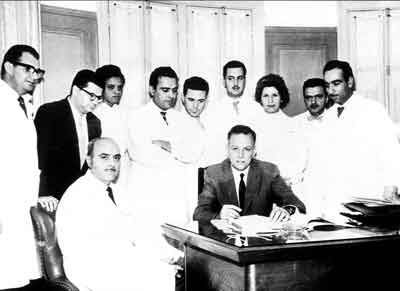
Historical photograph, taken in 1962 showing Professor Felipozzi (sitting on the left) and Dr. Charles Hufnagel (sitting on the right). Standing are the members of the pioneer team
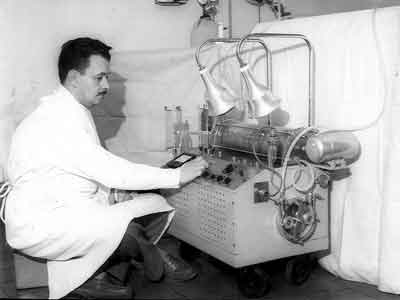
Dr. José dos Santos Perfeito, the first perfusionist of Brazil and one of the models the CPB machine built in the workshops of the "Sabbado D'Angelo" Heart Institute
The contribution of Professor Felipozzi was not restricted to the development of cardiopulmonary bypasses and to the first open heart surgeries in Brazil. Using his enterprising and tenacious spirit during the first years of heart surgery, he had the opportunity of creating the first mechanical and biological valve prostheses and plastic tubes (nylon) to substitute the aorta. He performed the first heart bypass in Brazil, the transplantation of a human aortic valve, intra-operative autotransfusion in heart surgery, and the creation of the Intensive Care Unit.
In Brazil he was also the pioneer in developing disposable plastic oxygenators produced by Lifemed.
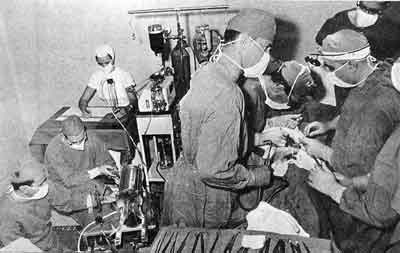
First heart surgery using total cardiopulmonary bypass, on November 12th, 1956 - Operating are Dr. Hugo J Felipozzi (right), Dr. Rubens G. Santos (1st assistant) and Dr. Laio G. D'Oliveira (2nd assistant)

First heart surgery using total cardiopulmonary bypass on November 12th, 1956 - In control of the electrocardiogram is Dr. Adauto Barbosa Lima (right). In charge of the conduction and control of the CPB are Drs. José dos Santos Perfeito and Sérgio Paladino. In charge of anesthesia is Dr. Pedro Geretto (at the back)
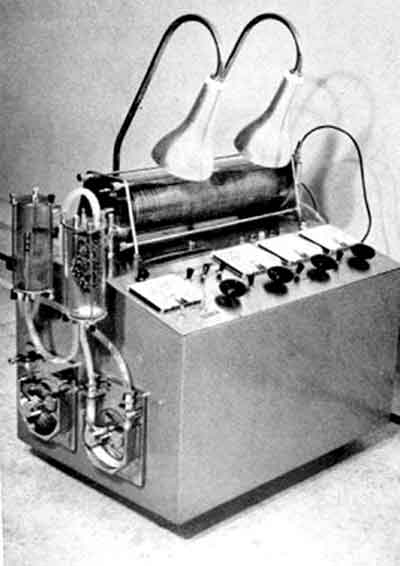
CPB machine used since 1959 with roller pumps and Kay-Cross-type disc oxygenator
As well as directing of Cardiovascular Surgery Service of the Sabbado D'Angelo Cardiology Institute (Instituto de Cardiologia Sabbado D'Angelo) of the Anita Pastore D'Angelo Foundation, he was also professor of thoracic surgery in the Paulista Medical School (Escola Paulista de Medicina) and Medical Sciences University of Santa Casa in São Paulo.
At the Paulista Medical School, he worked together with Professor Costábile Gallucci building up the Thoracic Surgery Department.
He was also, at different times, head of the Cardiology and Pulmonary Surgery Services of the Matarazzo, Heliópolis and Samaritano Hospitals.
He educated many disciples, now spread around Brazil and the continent. He was substituted in the Thoracic Surgery Department at the Medical Sciences University of Santa Casa de São Paulo when he retired by his student Prof. Dr. Luis Antonio Rivetti. At the Paulista Medical School, he guided many students, including Professors Enio Buffolo, Vicente Forte, José Carlos Andrade and Roberto Catani.
Professor Hugo João Felipozzi died in São Paulo at 81 years old, on November 5th, 2004.
The immense contribution that Professor Hugo João Felipozzi gave to Brazilian heart surgery has been acknowledged. With his enterprising vision and subtle leadership, professional ethics, work and bringing together people, he was able to compose a team of researchers of the national scientific elite, to consolidate and construct the foundations that would make a way for the work of the "giants" that fortified Brazilian heart surgery. Without any doubts, the course of the Brazilian heart surgery would have been different without his contribution. With our homage, the eternal gratitude of his disciples, friends and colleagues will be registered.
ACKNOWLEDGEMENTS
We wish to thank Prof. Dr. Rubens de Guimarães Santos, partner and life-long loyal friend of Prof Hugo J. Felipozzi, for his revision and correction of this text.
BIBLIOGRAPHIC REFERENCES
1. Costa IA. História da cirurgia cardíaca brasileira. Rev Bras Cir Cardiovasc. 1998;13(1):1-7.
2. Felipozzi HJ, Santos RG, D'Oliveira LG, Perfeito JS. Cirurgia cardíaca a céu aberto com desvio extracorpóreo da circulação do coração direito. Resultados experimentais e primeiros casos clínicos. Nota prévia apresentada ao Departamento de Cirurgia da Associação Paulista de Medicina ,em 16 de Novembro de 1955.
3. Zerbini EJ, Curti P, Prata L, Felipozzi H, Margutti R, Galucci C. Tratamento cirúrgico das lesões da válvula mitral em 208 casos. Rev Assoc Med Bras. 1957;3(1):25-32.
4. Andreasen AT, Watson F. Experimental cardiovascular surgery: further experiments on the azygos factor. Br J Surg. 1953;40(164):616-21.
5. D'Oliveira LG, Felipozzi HJ, Santos RG. Surgery under direct vision for the correction of pulmonary stenosis with intact ventricular septum. Surgery. 1957;41(2):227-35.
6. Warden HE, Read RC, DeWall RA, Aust JB, Cohen M, Ziegler NR et al. Direct vision intracardiac surgery by means of a reservoir of "arterialized venous" blood: description of a simple method and report of the first clinical case. J Thorac Surg. 1955;30(6):649-57.
7. DeWall RA, Gott VL, Lillehei CW, Read RC, Varco RL, Warden HE et al. A simple, expandable, artificial oxigenator for open heart surgery. Surg Clin North Am. 1956;103:l025-34.
8. Berne RM, Cross FS, Hirose Y, Jones RD, Kay EB. Evaluation of a rotating disc type reservoir-oxygenator. Proc Soc Exp Biol Med. 1956;93(2):210-4.
9. Felipozzi HJ, Santos RG, D'Oliveira LG, Perfeito JS. Coração-pulmão artificial na cirurgia dos de-feitos do septo auricular, sob controle direto da visão. Arq Bras Cardiol. 1956;9:214.
10. Felipozzi HJ, Santos RG, D'Oliveira LG, Perfeito JS. Cirurgia dos defeitos do septo ventricular com visão direta pelo emprego do coração-pulmão artificial. Arq Bras Cardiol. 1958;11:195.
11. Felipozzi HJ, Santos RG, D'Oliveira LG, Perfeito JS, Gereto P, Paladino S. Experiência atual da correção radical dos defeitos intra-cardíacos sob visão direta com emprego do coração pulmão artificial. Arq Bras Cardiol. 1958;11:249.
12. Paladino S, Perfeito JS, Santos RG, D'Oliveira LG, Felipozzi HJ. Aspectos fisiológicos das intervenções cardíacas com o emprego do conjunto coração-pulmão artificiais. Rev Paulista Med. 1958;53:224.
13. Felipozzi HJ, Santos RG, D'Oliveira LG, Perfeito JS. Coração e pulmão artificiais para a cirurgia intracardíaca. Separata da revista "Hospital de Hoje". Volume 6, primeiro trimestre de 1957.









 All scientific articles published at rbccv.org.br are licensed under a Creative Commons license
All scientific articles published at rbccv.org.br are licensed under a Creative Commons license